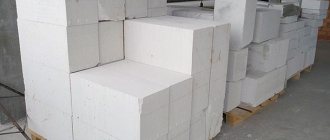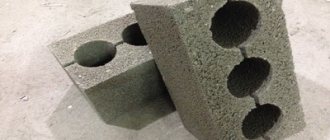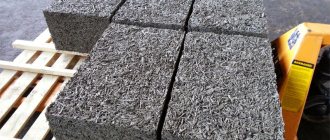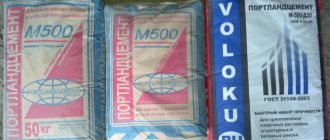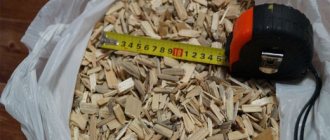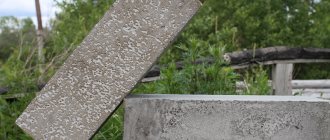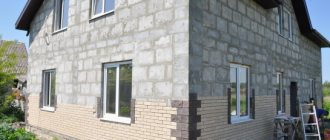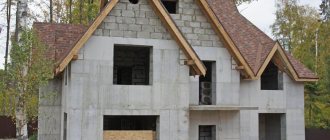Fiber-reinforced concrete is a new fine-grained material that appeared on the market relatively recently, but due to its performance characteristics it has already gained popularity. Fiber-reinforced concrete is concrete that contains not only all the components of the solution, but also reinforcing fiber fiber.
Fiber-reinforced concrete additives are identical in thickness and length and are distributed evenly in the structure. The smallest fibers can be made from different materials; they act as reinforcing reinforcement, increase the strength of the concrete structure, and improve its properties.
Fiber: types of materials and their classification
To understand what fiber-reinforced concrete is, it’s worth delving a little deeper into history. The material was first presented in 1907 by the Russian scientist V.P. Nekrasov in his articles talked about research into the production of a composite material reinforced with pieces of thin wire.
Previously, builders added various dispersed fibers to the solution and distributed them evenly throughout the mass. This made it possible to improve the properties of concrete: reduce the number of cracks, increase resistance to external factors and physical stress, and increase the strength index by an average of 30%.
Reinforcement of the concrete mixture is made using artificial fibers from different types of non-metallized and metalized threads of mineral or organic origin. The physical and technical properties of the material (thermal conductivity, strength, density), resistance to chemicals directly depend on the characteristics of concrete preparation and the type and volume of fiber introduced into the mixture.
Today, the production of fiber-reinforced concrete is carried out on an industrial scale, all technologies have been tested and improved, and the characteristics of the material can be calculated in advance based on its parameters. Two types of fiber are used in production: non-metallic (acrylic, glass, polyethylene, basalt, carbohydrate, carbon, etc.) and metallic (steel fibers of different sizes and shapes).
The most popular are metal and glass fibers; polypropylene fiber is gradually gaining popularity. Carbon and basalt are rarely used due to their high cost. Viscose, cotton, nylon provide concrete with specific features that are not always relevant in modern construction.
Main types of fiber fiber
Based on production methods and origin, fiber is classified into six main categories, in accordance with GOST 14613-83 “Fiber. Technical conditions". The composition of fiber-reinforced concrete is determined by the standards specified in GOST, production is carried out in compliance with technology. Thanks to this, fiber-reinforced concrete products demonstrate established properties and characteristics that directly depend on the type of fiber.
Types of fiber that are included in the composition:
1) Steel fiber - can be anchor or wave, the fibers are wave or straight pieces of wire 10-50 millimeters long with bent ends, made by melt molding or mechanical, electrical methods. The technology is selected according to the fiber diameter.
Steel fiber is used to increase the strength of the structure and exhibits excellent wear resistance. Among the disadvantages, it is worth noting the low level of corrosion resistance, the high weight of the finished product, and not very good adhesion to the concrete base.
2) Fiberglass fiber – filaments of inorganic glass are used as filler, which are obtained by drawing out molten glass mass in special installations. The properties of the threads directly depend on the chemical structure of the glass and the method of obtaining the material.
The structural and mechanical properties of fiber-reinforced concrete with glass fiber can be very different and depend on the length, strength, and thickness of the fibers. The material is plastic, but is afraid of an alkaline environment.
3) Basalt fiber is a mineral inorganic fiber of artificial origin, which is obtained from a mineral of volcanic origin melted in furnaces. The threads demonstrate the following properties: resistance to mechanical stress, resistance to acids and alkalis, and combustion.
On average, concrete is strengthened three times. Examples of using basalt fiber fiber: plinth panels of high-rise buildings, walls and monoliths, interior partitions, sculptures, fountains, reconstruction details, facade decor, permanent formwork for pile foundations, road slabs, etc.
4) Carbon fiber - chopped pieces of threads that are obtained from carbon through heat treatment at maximum temperatures. Guarantees excellent resistance of building structures to mechanical loads and chemical reactions.
Main advantages: fiber is not afraid of corrosion, has high adhesion, resistance to acids and alkalis, and elevated temperatures. The elasticity is higher than that of steel fibers, and the strength is identical to that of glass fiber. The only negative is the high price.
5) Cellulose fiber is a polymer hydrocarbon material that does not dissolve in water and is not afraid of fire or acids. It has a good effect on the vapor permeability of the polymer coating, slows down shrinkage, and helps remove moisture from the lower layers of the screed to the surface of the fiber-reinforced concrete.
6) Polypropylene fiber - synthetic fibers with a cross section of 0.02-0.038 millimeters, which are made from propylene film by cutting and twisting. In concrete, the fiber opens up and creates a mesh structure, guaranteeing a significant improvement in the technical characteristics of fiber-reinforced concrete. Shows good resistance to impacts and chemical influences. Among the disadvantages it is worth noting the following: not very high resistance to compression and tension, high temperatures, variation in the quality of raw materials.
Nylon is used less frequently; viscose and other fibers are sometimes used to impart specific properties to concrete. When choosing fiber-reinforced concrete blocks, first of all, it is necessary to determine the correct fiber for repair and construction work, taking into account operating conditions, loads, functions, and cost.
The difference between wood wool material and other wood concrete
Compared to other wood concrete, fiber-reinforced concrete has higher fracture strength , because long wood wool plays the role of high-quality reinforcement.
In addition, with the same density and thickness, fiber-reinforced concrete has slightly lower thermal and sound conductivity , this is caused by the large length of the chips and their frequent location across the slab.
Another difference between fiber-reinforced concrete is the much higher price per m³, because for ordinary wood concrete, waste from machine processing of wood is used, and wood wool is the final product of planing on a special machine.
Advantages and disadvantages
When trying to figure out what fiber-reinforced concrete is, you need to understand that all the main characteristics depend on the materials used in its production and adherence to technology. But there are certain properties that are characteristic of all types of fiber-reinforced concrete, which must be taken into account when planning work.
The main advantages of fiber-reinforced concrete:
- Reduced construction costs - by increasing the strength of slabs, reinforcement can be abandoned, reducing the duration of work, the cost of additional materials, their transportation, and installation
- Increasing the strength of finished structures - the technology for the production of fiber-reinforced concrete of any type suggests that such material is not afraid of shrinkage, does not become covered with cracks, chips, guaranteeing even higher strength than in structures with reinforcement
- Excellent adhesive properties
- Resistance to sudden changes in temperature, moisture, cooling/thawing
- Non-combustibility - a concrete structure reinforced with a composite prevents damage to the structure of the monolith and the appearance of cracks under the influence of high temperatures
- The lightness of fiber-reinforced concrete blocks, which reduces transportation and installation costs
- Savings on building materials - due to a significant increase in strength, the foundation or walls can be made with a smaller monolith thickness without sacrificing stability and reliability
- Extending the service life - the introduction of fiber fibers allows you to achieve a longer service life of concrete while maintaining all important performance characteristics
- Reducing concrete consumption
The only disadvantage is the relatively high cost of fiber-reinforced concrete. To prepare the solution, you need to buy expensive materials; ready-made fiber-reinforced concrete blocks are also more expensive than ordinary concrete ones. But savings in subsequent stages of construction and operation of the building completely cover this disadvantage.
Varieties
Fiber-reinforced concrete is concrete to which fibers (fiber) of various materials have been added to increase strength. The most popular fiber is from :
- wood;
- glass;
- basalt;
- polyethylene;
- various plastics;
- become.
Typically, the composition of such concrete, in addition to fiber, includes cement and sand , and the more sand, the more durable and dense the hardened concrete stone is.
Therefore, to produce finishing elements from various grades of concrete, sand is removed and air-entraining additives are added .
Thanks to this, the frozen material acquires a low load-bearing capacity, but its heat and sound insulation properties increase.
Production of reinforced fiber concrete
Considering fiber-reinforced concrete and its use in construction, it is worth noting that the most important condition for good material characteristics is its correct production. Whether it is production in a factory or mixing the solution with fiber with your own hands, it is important to correctly determine the composition, proportions, and follow the technology of creation and use.
Industrial production
The technology depends on the type of fiber and the proportions of concrete components. The density of fiber-reinforced concrete is ensured by the most uniform distribution of fibers in the solution and correct orientation in the mixture. It is the uniformity of the fibers in the monolith that has a direct impact on the ability of the concrete structure to withstand external mechanical loads and chemical conditions.
The main stages of the production of any fiber-reinforced concrete: preparation of the solution, formation of fiber fibers, cutting them according to parameters, adding to the mixture, high-quality stirring, compaction, pouring into the mold, hardening of the monolith.
Depending on the type of fibers used, which can be metallic or non-metallic, the step of creating the fiber and adding it to the solution may vary. Steel fiber is cut from a metal strip, glass fiber is formed from a molten mass, cellulose fiber is cut and rolled into tubes, which are then straightened and create a network in the solution. The distribution of fiber in the solution can also be carried out in different ways, but with the sole purpose of ensuring maximum uniformity.
Plasticizers are often added to the mixture, which increase the level of plasticity of the concrete itself, which has a positive effect on the quality of the material. Plasticizers allow you to control the speed of concrete setting and regulate the level of shrinkage.
Preparation at the construction site
The reinforcing filler can be added to the solution immediately before its use on site. Here the following technology is followed: mixing sand with filler, introducing fibers sifted through a sieve, combining them with cement, pouring water with a plasticizer. High-quality mixing until a homogeneous mass is obtained.
The finished mixture is poured into molds and left for three days to set. Then it is better to dry it not in the open air.
Scope of use
The scope of application of fiber-reinforced composite differs depending on the characteristics of the filler.
The steel fiber reinforced composite is used for the construction of:
- Railway sleepers, building foundations, bridge coverings, breakwaters.
- Transport tunnels and floors capable of withstanding significant forces.
- Sidewalks, road surfaces, airfield bases.
- Decorative tiles, borders.
- Monolithic structures, building frames.
- Underground drainage lines, special communication wells, hydraulic structures, water treatment structures.
It allows you to obtain durable and relatively lightweight architectural elements of any configuration
Concrete with the addition of glass fiber differs in its scope of use. It is indispensable for the following purposes:
- production of noise protection structures installed along intensive highways;
- waterproofing protection of water treatment facilities;
- production of decorative finishing products;
- finishing of facades of residential buildings;
- finishing of industrial premises that do not absorb dirt and are easy to clean;
- production of decorative elements used in solving problems related to landscape design, fencing, canopies.
Fiber-based composites are in demand when carrying out construction activities. On its basis, concrete structures are erected that can withstand significant forces:
- Foundations for vehicle parking, road surfaces, reinforced foundations of critical facilities.
- Hydraulic structures, concrete tanks, railway facilities.
The use of polypropylene filler makes it possible to use composite concrete in the manufacture of:
- foam block products;
- porous concrete composites;
- small-sized buildings.
The color range of fiber-reinforced concrete is very wide, which allows you to create structures that completely imitate natural stone
The use of viscose fibers and the addition of cotton have limited use in the manufacture of textile concrete.
Application of composite fiber concrete
The use of the material is relevant in domestic and industrial construction wherever it is necessary to improve the properties of concrete. Steel fiber-reinforced concrete is used for the production of: bridge coverings, floors, tunnels, bank protection strips, foundations, sleepers, roads, runways, sidewalks, structural frames, curbs, drainage channels, dams, sewerage well shafts, water treatment systems, fiber-reinforced concrete floors.
Fiberglass concretes are relevant for: façade finishing with fiber-reinforced concrete of residential buildings, waterproofing of cleaning structures, noise protection shields, light decorative products for finishing coatings, industrial premises with frequently contaminated coatings, benches, fences, flower beds.
Basalt fiber-reinforced concrete is used in the construction of foundations, floors, roads, dams, reservoirs, and railway structures. Polypropylene fibers are used in the construction of low-weight objects, cellular concrete, and foam block structures. Viscose and cotton fibers are needed for mixing textile concrete, which is increasingly used in modern construction.
Lightweight porous concrete
Among the variety of this type of materials, foam-fiber concrete and gas-fiber concrete stand out. Gas-fiber concrete is a non-autoclaved cellular material that is reinforced with fiber fiber. The production of such concrete is simple; the material is used in the creation of wall blocks, other elements for thermal insulation of floors, and roofs in individual housing construction.
The main properties of gas-fiber concrete: density about 550 kg/m3, low thermal conductivity, safety and environmental friendliness, efficiency (a ton of dry mixture gives about 2 m3 of gas-fiber concrete). In terms of properties and characteristics, foam-fiber-reinforced concrete is almost identical to gas-fiber-reinforced concrete; it is used mainly for the construction of low-rise buildings and thermal insulation.
The introduction of fiber fiber into concrete mixtures can significantly improve the following indicators of concrete: strength, resistance to mechanical and chemical influences, service life, thermal insulation properties. When choosing a specific material, the type and characteristics of the fiber, the operating conditions of the future structure, and important requirements for the monolith are taken into account. Provided that the production technology is followed and the choice of fiber is correct, the material will provide all the necessary indicators and parameters.
Regulations
This material is subject to several GOSTs adopted in Russia and the USSR:
- GOST R 54854-2011 “Lightweight concrete based on organic aggregates of plant origin”;
- GOST 19222-84 “Wood concrete and products made from it”;
- GOST 25192-2012 “Concrete. Classification and general technical requirements";
- GOST 26633-2012 “Heavy and fine-grained concrete. Technical conditions".
These documents describe only general requirements for fiber-reinforced concrete and do not cover the entire range of materials of this type.
For example, fiber-reinforced concrete with a density of 1200–1500 kg/m3 does not meet the requirements of these documents, but houses have been built from it for many decades.
This confirms the quality of the material and the possibility of its use in low-rise construction.
Therefore, all serious manufacturers of fiber-reinforced concrete based on wood wool and products made from this material conduct research to determine the optimal formulation and production technology that allows them to create a mixture that is most suitable for certain tasks.
